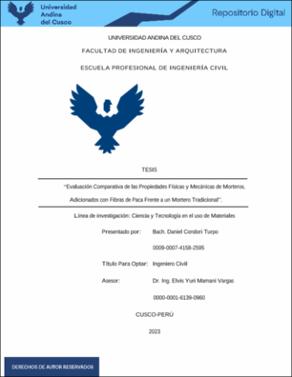| dc.contributor.advisor | Mamani Vargas, Elvis Yuri | |
| dc.contributor.author | Condori Turpo, Daniel | |
| dc.date.accessioned | 2024-05-07T18:02:02Z | |
| dc.date.available | 2024-05-07T18:02:02Z | |
| dc.date.issued | 2023-12-19 | |
| dc.identifier.uri | https://hdl.handle.net/20.500.12557/6335 | |
| dc.description.abstract | El trabajo de investigación consistió en evaluar comparativamente las propiedades físicas
y mecánicas de morteros adicionados con fibra de paca(Guadua weberbaueri Pilger) frente a un
mortero tradicional se analizó las propiedades físicas y mecánicas mediante ensayos comparativos
en estado fresco y endurecido, en el estado fresco se determinó en qué medida altera la fluidez del
mortero y en qué medida se altera la fisuración en la contracción plástica del mortero y en el estado
endurecido se determinó en qué medida varia la resistencia a la compresión y la resistencia a la
flexión del mortero con la adición de fibras de paca en 300 g/m3; 600 g/m3 y 1000 g/m3 frente a
un mortero tradicional. El diseño de mezcla se realizó utilizando los materiales como arena fina
de Cunyac, cemento portland tipo IP, aditivo y fibra de paca en sus diferentes dosis en 300 g/m3;
600 g/m3 y 1000 g/m3 para lo cual se realizó 6 ensayos para cada dosis, 24 muestras para 7, 14 y
28 días que en total de muestras serian 72 muestras para resistencia a compresión y 72 muestras
para resistencia a flexión, para el ensayo de contracción plástica un ensayo para cada dosis que
hacen total de 4 muestras ensayadas. En la contracción plástica se pudo determinar que cuanta más
fibra se incrementa el mortero más se reducen tanto la longitud como el ancho de la grieta y en la
resistencia a la compresión y flexión, la adición de fibra es significativa si y solo si se acompaña
el efecto del tiempo de curado. Finalmente, se concluyó que la dosis de fibra de paca en estado
fresco afecta directamente y de forma significativa a la reducción tanto de la longitud como al
ancho de las grietas formadas por retracción plástica del mortero, y en el mortero en estado
endurecido no es significativa su resistencia a la compresión ni la resistencia a la flexión. | es_PE |
| dc.description.abstract | The research work consisted of comparatively evaluating the physical and mechanical
properties of mortars added with bale fiber (Guadua weberbaueri Pilger) compared to a traditional
mortar. The physical and mechanical properties were analyzed through comparative tests in the
fresh and hardened state, in the fresh state. It was determined to what extent the fluidity of the
mortar is altered and to what extent cracking is altered in the plastic contraction of the mortar and
in the hardened state it was determined to what extent the compressive strength and flexural
strength of the mortar vary with the addition of bale fibers at 300 g/m3; 600 g/m3 and 1000 g/m3
compared to a traditional mortar. The mix design was carried out using materials such as fine
Cunyac sand, IP type Portland cement, additive and bale fiber in their different doses at 300 g/m3;
600 g/m3 and 1000 g/m3 for which 6 tests were carried out for each dose, 24 samples for 7, 14
and 28 days, which in total samples would be 72 samples for compression resistance and 72
samples for flexural resistance, for the plastic contraction test, one test for each dose, making a
total of 4 samples tested. In plastic contraction it was determined that the more fiber the mortar
increases, the more both the length and width of the crack are reduced and in the resistance to
compression and flexion, the addition of fiber is significant if and only if it is accompanied by
effect of curing time. Finally, it was concluded that the dose of bale fiber in the fresh state directly
and significantly affects the reduction of both the length and width of the cracks formed by plastic
shrinkage of the mortar, and in the mortar in the hardened state it is not significant. its compressive
strength or flexural strength. | en_US |
| dc.format | application/pdf | es_PE |
| dc.language.iso | spa | es_PE |
| dc.publisher | Universidad Andina del Cusco | es_PE |
| dc.rights | info:eu-repo/semantics/openAccess | es_PE |
| dc.rights.uri | https://creativecommons.org/licenses/by-nc-nd/4.0/ | es_PE |
| dc.subject | Mortero | es_PE |
| dc.subject | Contracción plástica | es_PE |
| dc.subject | Tiempo de fraguado | es_PE |
| dc.subject | Peso unitario | es_PE |
| dc.title | Evaluación comparativa de las propiedades físicas y mecánicas de morteros, adicionados con fibras de paca frente a un mortero tradicional | es_PE |
| dc.type | info:eu-repo/semantics/bachelorThesis | es_PE |
| thesis.degree.name | Ingeniero Civil | es_PE |
| thesis.degree.grantor | Universidad Andina del Cusco. Facultad de Ingeniería y Arquitectura | es_PE |
| thesis.degree.discipline | Ingeniería Civil | es_PE |
| dc.publisher.country | PE | es_PE |
| dc.subject.ocde | https://purl.org/pe-repo/ocde/ford#2.01.01 | es_PE |
| renati.advisor.dni | 41610570 | |
| renati.advisor.orcid | https://orcid.org/0000-0001-6139-0960 | es_PE |
| renati.author.dni | 42505592 | |
| renati.discipline | 732016 | es_PE |
| renati.juror | Alvarez Espinoza, Jorge | |
| renati.juror | Somocurcio Alarcón, Hector Erick | |
| renati.juror | Aguilar Hilari, Adan Renzo | |
| renati.juror | Cana Paullo, Hugo | |
| renati.level | https://purl.org/pe-repo/renati/level#tituloProfesional | es_PE |
| renati.type | https://purl.org/pe-repo/renati/type#tesis | es_PE |
| dc.description.lineadeinvestigacion | Ciencia y Tecnología en el uso de Materiales | es_PE |




